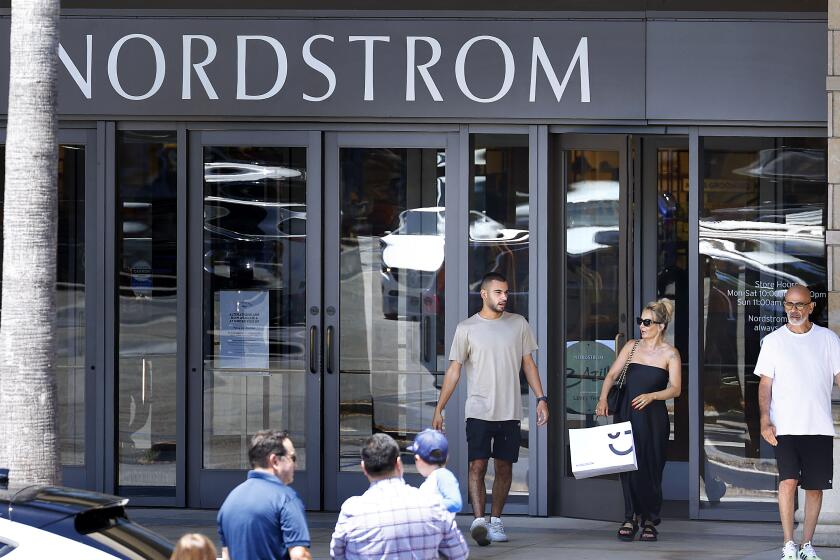California unemployment rate falls to 10.2% in September
- Share via
SACRAMENTO — California’s unemployment rate fell to 10.2% in September from 10.6% in August, posting one of the biggest drops of any state for the month.
The decline took the rate to its lowest level since March 2009, during the worst recession in half a century. It follows the announcement of a reduction in the national unemployment rate to 7.8% in September from 8.1% the prior month.
But the employment report released Friday has a less rosy side: The California Employment Development Department reported that only 8,500 net new payroll jobs were created statewide in September. The earlier U.S. Department of Labor posting could point to just 114,000 net new payroll jobs across the nation.
“It’s been pretty tough,” said Chad Clary, 25, a recent college graduate who moved to Santa Clarita from Alabama in search of an administrative position. “There are a lot more opportunities out here, but there are a lot more people here.”
The market, he noted, is jammed with older people, who can’t afford to retire.
That’s the spot in which Elvia Morgan, 60, of Los Angeles finds herself. She lost her credit union job of 36 years and now competes with applicants less than half her age.
“There’s age discrimination. Let’s face it,” she said at a Los Angeles City College job fair Thursday. “If I go in with more experience and a 20-something-year-old girl applies as well, they’re going to get the girl.”
Economists who track California said they weren’t surprised by the disparity between the falling unemployment rate and the modest number of new jobs. What’s important, they said, are longer-term trends, not month-to-month volatility.
“There’s no question the trend is in the right direction,” said Sun Won Sohn, who holds the Martin V. Smith professorship at Cal State Channel Islands. “The economy is moving, albeit not as fast as we’d like it to.”
Employment gains, though small in the last month, have been broad-based over the last year, he said. According to the Employment Development Department, a net 262,000 jobs — a rise of 1.9% — were generated by employers in the Golden State over the last 12 months, with significant jumps in information, up 6%; construction, 4.7%; professional and business services, 4.1%; leisure and hospitality, 4.1%; and educational and health services, 3.1%.
The biggest drop over the last year was in government jobs, down 1.7%, while manufacturing fell almost 1%.
In the Los Angeles metropolitan area, September seasonally adjusted joblessness fell to 10.6% from a revised 11% in August.
In the Inland Empire of Riverside and San Bernardino counties, the unadjusted rate dropped to 11.6% from a revised 12.3% in August. And in Orange County, the unadjusted rate was 7.1% in September, compared with a revised 7.7% in August.
Despite the improvement, California’s unemployment rate has remained stubbornly high compared with the rest of the nation. Only Nevada, at 11.8%, and Rhode Island, at 10.5%, were higher in September.
California still has far to go to get back the 3 million or so jobs that disappeared in the downturn that officially ended in June 2009 but whose effects are still being felt, warned Esmael Adibi, director of Chapman University’s A. Gary Anderson Center for Economic Research.
“There’s cause to have concerns that the pace of job creation, particularly with companies, is not picking up steam,” Adibi said. The economy still is being buffeted by economic head winds, he said, including a financial crisis in Europe, a slowdown in China, a budget deficit in Washington and the prospect of voter-approved tax hikes in California.
The difficulty landing a full-time job, or even a steady part-time job, could be behind the seemingly contradictory situation in which California’s monthly unemployment rate is going down while employers aren’t aggressively boosting their hiring, economists said.
Part of the answer is strictly statistical. The unemployment rate is derived from a small sampling of households, and the job figures come from a separate, more accurate survey of businesses that report on changes in their monthly payrolls.
Economists theorize that in recent months, survey respondents who don’t want or can’t find payroll jobs are identifying themselves as self-employed workers; they may not be earning much money. Such self-identifications would swell the number of people in the “total civilian employment” column, and, thus, mathematically decrease the unemployment rate.
The Employment Development Department reported an increase in total employment of 53,000 last month. . Many of the new workers likely are self-employed, such as commission sales persons, business consultants and other freelancers.
A small but consistent reduction over the last few months in the civilian labor force, caused by the long-term unemployed giving up their job searches, also could have contributed to a drop in the unemployment rate.
“Just because they dropped out of the payroll workforce, they didn’t stop receiving incomes,” said Christopher Thornberg, principal of Beacon Economics, a Los Angeles consultant.
Policymakers and business leaders should not read too much into California’s fluctuating monthly employment figures, Thornberg said.
“One month doesn’t tell us anything,” he said. “You’ve got to look at trends over the course of a year or six months.”
All in all, he said, “things are moving forward and the economy isn’t doing so badly.”
Lifsher reported from Sacramento and Flores reported from Los Angeles.
More to Read
Inside the business of entertainment
The Wide Shot brings you news, analysis and insights on everything from streaming wars to production — and what it all means for the future.
You may occasionally receive promotional content from the Los Angeles Times.












